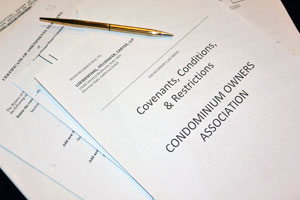In a perfect world, everyone would get along and there would not be a need for ways to resolve conflict. Unfortunately conflicts do arise and it is especially prevalent among homeowners residing in Common Interest Developments. Such conflicts may arise between the Board of Directors with an individual homeowner or between two (2) or more individuals. Typical areas where conflicts may arise pertain to architectural issues, pets, guest parking, various types of nuisances, etc. Covenants, Conditions & Restrictions (CC&R s) , By-laws, Rules and Regulations as well as the California Civil Code provide a process to resolve conflicts.
Associations generally have a policy regarding alleged violations of Association documents and Rules and Regulations. The process usually begins with the Board either being advised or determining that a homeowner has violated some aspect of the Association s documents. At that point, the Board, its attorney or management company issues a written notice of violation to the homeowner. If the problem/ violation continues, fines can be assessed against the offending homeowner. All compliance policies should contain provisions for the accused homeowner to attend a due process hearing in order to present their side of the story (their day in court). It is important that Boards of Directors allow the homeowner to tell his side of the story and that the board members listen to the homeowner s comments. A violation hearing should be as positive an experience as possible. Board members should be open to hearing the homeowner and not give the impression that they have already made up their minds that the homeowner is guilty before he even has an opportunity to speak. After the homeowner has had the opportunity to speak, the Board of Directors may take the matter under advisement and reach a decision after the homeowner has left the meeting.
Once a decision is reached, the Board can communicate the decision to the homeowner. If this were a perfect world, the hearing process would end any conflict. However, in the real world, matters may not be so easily resolved even when good methods of communication are utilized. Often the parties involved in the matter cannot reach a compromise and/or a decision and additional measures must be taken.
If issues cannot be resolved through the hearing process, it may be necessary to take further steps in conflict resolution which can be mediation or arbitration through ADR (Alternative Dispute Resolution). California Civil Code §1354 requires a party involved in a conflict to offer ADR to the opposing side prior to filing a lawsuit. A request for ADR is required if the association or homeowner is seeking solely declaratory or injunctive relief or declaratory or injunctive relief in Dealing With Differences and Conflicts Using Communication and Mediation conjunction with a claim for monetary damages not in excess of five thousand dollars ($5,000), related to the enforcement of the governing documents. Any party to the dispute may initiate the ADR process by serving on other parties a request for ADR and a notice that the party receiving the Request for Resolution is required to respond within thirty (30) days of receipt or the request will be considered to be rejected. (A copy of Civil Code §1354 as well as a sample ADR request form and response to request form are attached.)
There are two methods of ADR, Mediation and Arbitration. Additionally there are two types of Arbitration, binding and non-binding. In order to utilize ADR both parties need to agree to use ADR and also agree on which method to use. If the party requested to enter into ADR refuses, or fails to respond within thirty (30) days of the request, the person requesting ADR then has the right to file a lawsuit.
Mediation and Arbitration offer a less formal and less expensive method of conflict resolution than the court system. Arbitration can be binding or non binding. In binding arbitration the decision of the arbitrator is final and both parties are required to adhere to the decision. Non binding arbitration does not require compliance with the decision. Arbitrators are usually attorneys or retired judges, and are chosen by the parties involved in the conflict.
The other method of ADR, mediation, is not binding and as with arbitration the mediator is chosen by the parties involved in the conflict. A mediator may be an attorney, retired judge or a professional in the association management industry. At a mediation both sides provide input and their view of the issue. The mediator listens and provides what he considers to be a fair resolution to the matter. Mediation and arbitration are not always successful. If the parties involved communicate in a negative manner, if they are not listening to what is being said, or if they enter the mediation with a predisposed decision this method of conflict resolution may not work.
Steps To Take For Successful Mediation:
• Be prepared – bring to the mediation any documentation that is pertinent to the dispute;
• Utilize good communication skills – body language – listening skills – positive statements;
• Be reasonable and ready to compromise;
• Focus on the issues involved – do not make this a personal matter;
• Consider the measures the mediator is presenting – be open minded;
• Be prepared to pay for your portion of the mediator s charges;
• Be prepared to work hard at resolving the matter;
• Remember that after this matter is resolved – the opposing sides will still be neighbors;
Steps To Take For Successful Arbitration
• Be prepared – bring pertinent documents, including governing documents, letters etc.;
• Be knowledgeable of relevant statutory code sections;
• Understand California case law ;
• Bring witnesses to the arbitration if appropriate;
Mediation and arbitration can be a long process with little or no positive results. If the process does
not work, parties involved in the dispute may need to continue the dispute by beginning a suit and
going through the court system. Mediation and arbitration can work if the parties involved are
willing to listen, compromise, and remain open about a solution to the matter.


